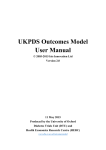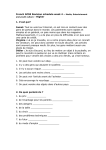Download ANNEX A A user guide to key statistics in Public Service Productivity
Transcript
ANNEX A A user guide to key statistics in Public Service Productivity Estimates: Education 2011 Statistic Strengths Limitations Suggested interpretation Education productivity time series Provides trend in productivity of UK education provision. Provides only a single measure of technical efficiency of education provision i.e. how volumes of input are translated into volumes of output. Positive productivity growth over medium term indicates that UK is achieving more qualityadjusted output per unit of input. Underlying data on output and inputs is detailed and comprehensive. Changes in the quality of provided services are taken into account. Does not say anything about changes in input prices or how productivity relates to expenditure on education services. Negative productivity over the medium term indicates that the UK is achieving less quality-adjusted output per unit of input than in the past. Changes in productivity can come about as a result of different mix of inputs e.g. more or less capital combined with higher or lower skilled labour, or from the use of new technology which changes the efficiency of provision. Does not say whether an increase or decrease in productivity necessarily leads to an increase or decrease in value for money1 . Quality-adjusted output Creates an index of education output that includes changes in the Average Point Score (APS) for exam performance of 16 year olds in the UK as a measure of quality. The qualityadjustment methodology is currently being reviewed by ONS. A method is being sought which is in line with forthcoming ESA 2010 guidance for National Accounts, and is robust to changes in policy which affect GCSE and equivalent attainment measures. Quality-adjusted output series shows how much education is provided when a measure for quality or the education output is also included. The current qualityadjusted output based on APS results is not included in UK National Accounts. Education quantity Provides estimate of UK education activity based on Full-time Equivalent (FTE) pupil and student numbers in a range of education settings in the UK. Geographic coverage for some education settings is not complete. Assumptions are made that these data move in line with the rest of the UK. Quantity series is a cost weighted index of education output. It shows how much education is provided, eliminating the effects of changing unit costs. This series is included in the UK National Accounts quarterly and Annual GDP(E) figures. 1 Value for money is commonly understood to refer to how far expenditure on a public service achieves its desired outcome for society. Value for money is therefore a function of how much is paid for inputs to the public service, the productivity of that public service (how inputs are converted to outputs) and how far the output of the public service delivers the desired outcome for society (independently of other social or economic factors). ONS public service productivity figures only cover one of these interactions. It is therefore not possible to say that a rise or fall in productivity is necessarily associated with better or worse value for money, unless more information is known about changes in input prices and the relationship between output and outcomes. Volume of inputs Provides estimate of the volume of inputs used in the provision of publicly funded education in the UK. Uses administrative and financial records to construct input information. Some financial data sources are subject to revision due to implementation of revisions in UK National Accounts. These are explained in the revisions section of the article. Estimates show how volumes of input have been changing over time. Data does not show whether increased volume of inputs has produced more or less value for money. Further analysis of the costs of providing education compared to other areas of the economy is required in order to answer this question. Statistical contact: Fiona Massey 01633 651552 [email protected] Issuing body: Office for National Statistics








